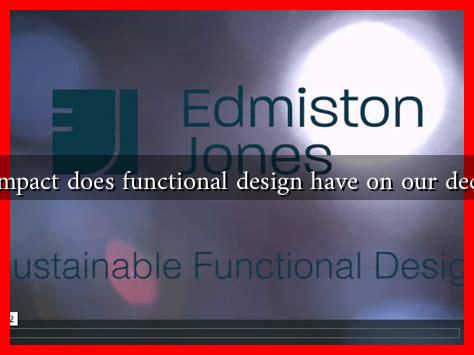-
Table of Contents
What Impact Does Functional Design Have on Our Decisions?
Functional design is a concept that transcends mere aesthetics; it plays a crucial role in shaping our decisions in various aspects of life, from consumer behavior to workplace productivity. This article explores how functional design influences our choices, the psychology behind it, and real-world examples that illustrate its significance.
The Psychology of Functional Design
Functional design refers to the creation of products, environments, or systems that prioritize usability and efficiency. The psychological impact of functional design can be profound, as it directly affects how we perceive and interact with our surroundings. Here are some key psychological principles at play:
- Perception of Value: Well-designed products often convey a sense of quality and reliability. For instance, Apple’s minimalist design philosophy not only enhances usability but also creates a perception of premium value.
- Ease of Use: Functional design simplifies decision-making by reducing cognitive load. When users can easily navigate a product or service, they are more likely to engage with it.
- Emotional Connection: Aesthetically pleasing and functional designs can evoke positive emotions, leading to brand loyalty. For example, IKEA’s functional yet stylish furniture encourages customers to envision their living spaces, influencing purchasing decisions.
Functional Design in Consumer Products
In the realm of consumer products, functional design can significantly impact purchasing decisions. Consider the following examples:
- Smartphones: The design of smartphones, such as the Samsung Galaxy series, emphasizes user-friendly interfaces and ergonomic shapes. This functionality leads consumers to choose these devices over competitors.
- Kitchen Appliances: Brands like Breville focus on functional design by creating appliances that are not only efficient but also visually appealing. This dual focus attracts consumers who value both performance and aesthetics.
- Automobiles: Tesla’s functional design integrates technology with sustainability, appealing to environmentally conscious consumers. The user interface and autopilot features enhance the driving experience, influencing buyers’ decisions.
Functional Design in Workspaces
The impact of functional design extends beyond consumer products; it also plays a vital role in workplace environments. A well-designed workspace can enhance productivity and employee satisfaction. Here are some ways functional design influences workplace decisions:
- Layout and Flow: Open office designs promote collaboration and communication, leading to better teamwork. Companies like Google have adopted this approach to foster innovation.
- Ergonomics: Ergonomically designed furniture reduces physical strain, leading to healthier employees. Research shows that companies investing in ergonomic solutions see a decrease in absenteeism and an increase in productivity.
- Technology Integration: Workspaces equipped with functional technology, such as smart boards and video conferencing tools, facilitate seamless communication and decision-making.
Case Studies: The Power of Functional Design
Several companies have successfully leveraged functional design to influence consumer decisions:
- Airbnb: The platform’s user-friendly interface and functional design allow users to easily navigate listings, leading to higher booking rates. The emphasis on user experience has made Airbnb a leader in the hospitality industry.
- Amazon: Amazon’s website design prioritizes functionality, with features like one-click purchasing and personalized recommendations. This design approach has significantly increased conversion rates and customer satisfaction.
Statistics on Functional Design Impact
Research supports the notion that functional design significantly influences decision-making:
- A study by the Design Management Institute found that design-driven companies outperformed the S&P by 228% over ten years.
- According to a report by McKinsey, companies that prioritize design see a 32% increase in revenue growth compared to their competitors.
Conclusion
Functional design is more than just a trend; it is a critical factor that shapes our decisions in both consumer and workplace contexts. By enhancing usability, creating emotional connections, and simplifying choices, functional design influences our perceptions and behaviors. As we continue to navigate a world increasingly driven by design, understanding its impact can empower us to make more informed decisions, whether we are consumers or creators.
For further reading on the importance of design in decision-making, you can explore resources from the Design Management Institute.


